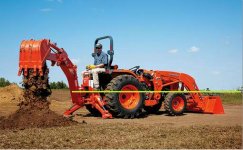AxleHub
Elite Member
I was wondering if the weight of the Front End Loader gives the tractor more stability if kept low while mowing the law and othe tasks that don't involve the FEL???
Greetings,
I've read about 18 responses to your questions with some good input in them. But if I can make it an even simpler answer with a couple terms not already used - here goes:
1. If you asked the same question of a race car or pickup truck driver they'd tell you . . . its all about the wheelbase (width and length) and height combination. The most important term is wheelbase because a FEL doesn't improve the wheelbase.
2. Cutting across a hill (side hill cutting) - the FEL instead of holding you down - puts an imbalanced weight on one front tire (the one on the downhill side). Stability comes from exactly the opposite - as a balanced weight load directly over your wheelbase axles gives you the best handling/stability.
3. Again - think of winter driving in a pickup truck. You want to add weight directly over the wheels - not in front - and not behind - for best traction on snow, ice, frost.
Just my input
